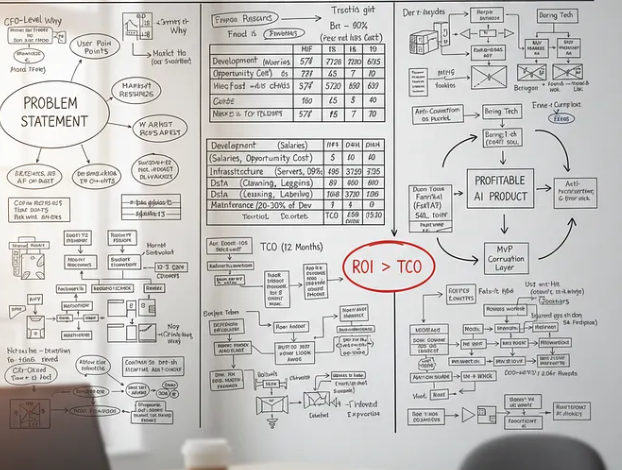Beyond the Prototype: The Founder’s Playbook

The tech world is drowning in impressive AI demos. With a few lines of code and a powerful API, anyone can build a prototype that feels like magic. But there is a massive, treacherous gap between a magical demo and a profitable, real-world product.
As a founder who has personally architected and built AI systems from the ground up, I’ve learned that the most critical work happens before you write a single line of code. It happens when you put on your CFO hat and treat the project not as a science experiment, but as a business venture.
Most AI projects fail not because the technology is wrong, but because the business case was never built. Here is the founder’s playbook I use to bridge that gap.
Step 1: Scope the Problem, Not the Solution (The “Why”)
The fastest way to kill a project is to fall in love with a solution. “We should use a RAG system!” or “Let’s build a computer vision pipeline!”
This is backward. The first question must always be: What is the most expensive, time-consuming, or frustrating problem our user has?
When I started designing my Full-Stack Culinary Operations System, the temptation was to build a flashy, AI-powered recipe generator. But after talking to restaurant owners, I realized their biggest financial drains were manual invoice data entry and food waste from poor inventory tracking.
That became the mission.
The MVP wasn’t a sexy recipe generator. It was a robust, “boring” pipeline that used Google Gemini Vision to ingest crumpled, unstructured invoices and turn them into structured JSON. It solved the most expensive problem first.
The Playbook: Before you spec out the tech, write a one-sentence problem statement that your CFO would understand. If you can’t, you don’t have a project; you have a hobby.
Step 2: Calculate the Real Cost of Your AI (The P&L)
A business leader will ask, “What’s the TCO (Total Cost of Ownership)?” As a technical leader, you must have the answer. It’s more than just API fees.
Development Cost: Your team’s salaries are the obvious part. The hidden part is the opportunity cost. The time they spend on this AI project is time they aren’t spending on other critical features. You must be certain the ROI is higher here.
Infrastructure Cost: Servers, databases, and vector storage are the baseline. Are you accounting for the cost of logging, monitoring, and staging environments? These are not optional.
Data Cost: Is your data ready? Or will you spend 80% of your time and budget on cleaning, labeling, and structuring it? Data wrangling is the single most underestimated expense in AI.
Maintenance Cost (The Iceberg): This is the cost that sinks companies. Models drift. APIs get updated. New edge cases emerge in production. I budget for at least 20–30% of the initial development cost for ongoing maintenance in the first year alone.
The Playbook: Create a simple spreadsheet that estimates these four cost categories over 12 months. This exercise transforms a vague technical idea into a concrete business investment.
Step 3: Architect for Profitability, Not Perfection (The “How”)
With a clear problem and a realistic budget, you can finally design the system. The goal now is not to build the most technically perfect system, but the most profitable one.
This means making pragmatic, business-driven architectural choices.
Choose “Boring” Technology: For the culinary platform’s backend, I chose FastAPI and SQLAlchemy. They are incredibly robust, well-documented, and easy to hire for. This wasn’t the time to experiment with an obscure new framework that would increase risk and development time.
Build for the MVP, Design for the Vision: The initial architecture solved for invoice processing, but I designed the database schema and service interfaces to accommodate future features like recipe costing and PoS integration. This avoids costly refactoring down the road.
Isolate Your Dependencies: Any third-party API (like a PoS system or an LLM) is a liability. I architect my systems with a clear separation layer (an anti-corruption layer), so if an API changes or we need to swap it out, I only have to rewrite one module, not the entire application. This drastically reduces long-term maintenance costs.
Conclusion: From Technologist to Business Builder
The leaders who will win in the next decade of AI will be those who can seamlessly move between the whiteboard and the balance sheet. They will be the ones who can justify an architectural decision with a financial model and explain the ROI of a new model to the board.
Building a successful AI product isn’t about having the most complex algorithm. It’s about having the clearest vision, the most honest budget, and a relentless focus on solving a real-world, expensive problem.